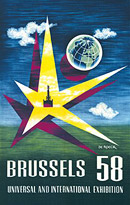| The Brussels
World's Fair was held from and attracted more than 42
million visitors.
 It
was the first major post war World Fair – the previous one having
been held in New York in 1939 when the German troops were invading Poland. It
was the first major post war World Fair – the previous one having
been held in New York in 1939 when the German troops were invading Poland.
The Brussels World Fair, more commonly known as EXPO
'58, was certainly the most extensive of all international
events of the fifties in the scope of its exhibits. It symbolised a democratic
desire for peace between nations, faith in technical progress (despite
fears about the atom bomb) and optimism about the future of a modern
world that promised to enhance people's lives.
To celebrate the anniversary of Expo '58 the organisers
of EuroFeria are making a special feature
of the Spanish Pavilion of 50 years ago
with photographs and a scale model of the building.� This has been
made possible with the help of the Spanish Embassy.
Make a note of the dates in your diary – 5, 6,
7 and 8 June 2008 and be sure to join us at the foot of the Atomium for
a weekend of celebration and intercultural exchange.
More
information → |
